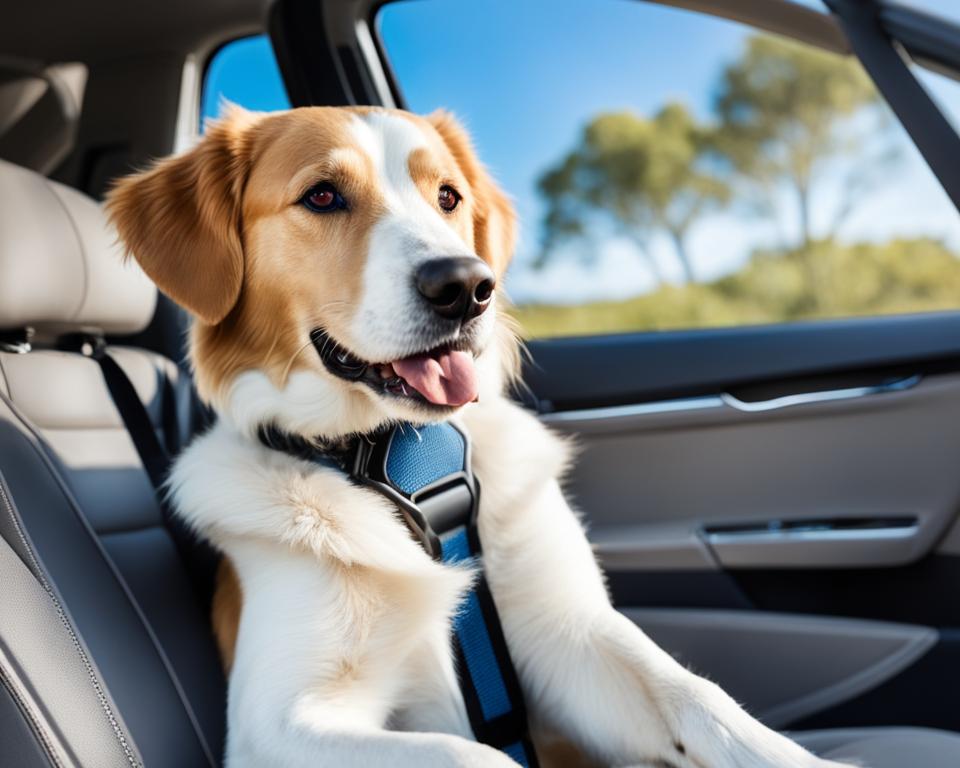Embarking on **dog-friendly car trips** demands a bit more than just picking a destination and hitting the road. As you prepare for **long distance travel with dogs**, prioritizing your furry friend’s safety and comfort becomes as important as your own. Nearly every dog lover understands the reluctance to leave their canine companion behind. In fact, a distinct 2018 study highlighted how the overwhelming majority consider their pets integral to their travel experiences. But to truly make the ride enjoyable for your loyal companion, understanding and applying **dog travel safety tips** is essential.
Whether you’re visiting relatives, exploring new landscapes, or taking that much-needed vacation, your preparation can make all the difference. A well-thought-out trip with your dog in tow means side-stepping the preventable mishaps and focusing on creating memorable experiences. Perhaps the most critical aspect of your planning involves securing your dog safely in the vehicle.
From the right restraint to the nuances of feeding schedules and travel kits, let’s delve into the essentials that ensure your dog’s tail wags contently throughout the journey.
Key Takeaways
- Invest in a secure restraint method, such as a carrier or pet seatbelt, specifically for the back seat of your car.
- Pre-trip car ride practices can make a world of difference in easing your dog into the experience of long-distance travel.
- Keep your dog’s eating schedule in check by feeding them several hours before hitting the road and only during breaks.
- Never underestimate the danger of leaving your dog in a parked car; temperatures can reach dangerous levels quickly.
- Prepare a comprehensive travel kit for your dog including health records, food, water, toys, and a first-aid kit.
- Proper ID tags and a microchip significantly increase the safety net for your dog in unfamiliar territories.
- Remember, adhering to safety guidelines not only protects your pet but also ensures a smoother, more enjoyable trip for everyone.
Understanding the Essentials of Dog Car Travel
When you’re **planning a road trip with dogs**, it’s crucial to think beyond the itinerary and ensure that every aspect of your furry friend’s needs is covered. A key component of **traveling with dogs in car long distance** involves meticulous preparation—gathering the vital **dog car travel essentials** that will safeguard their well-being and comfort. Let’s discuss how to pack intelligently, identity safeguards, and the importance of choosing the right restraint system for your canine companion.
Packing the Right Supplies for Your Dog
Setting out on an adventure with your dog means packing as though you have a toddler in tow. Consider what they’ll need for the duration of the journey—and then some. Your dog’s travel kit should be a repository of familiarity and comfort, containing not just essentials but also some indulgent items to keep their tail wagging.
- Amply sized water bottle to keep hydration levels optimal
- Portable, collapsible bowls for water and feeding moments
- Their usual dog food to avoid any gastrointestinal surprises
- Favorite toys and a new toy to pique their interest
- A cozy blanket or bed to signify safe space
- Cleanup accessories like waste bags and a hand-held vacuum for shedding fur
- A comprehensive pet first aid kit
Ensuring Proper Identification and Documentation
As the saying goes, better safe than sorry—especially when it comes to **traveling with dogs in car long distance**. Your dog needs to be identifiable at all times, should the unthinkable happen and they become separated from you. To that end, ensure their collar is fitted with an up-to-date ID tag bearing your current contact information, along with temporary tags that might include details of your destination.
Remember, a microchipped dog stands a much higher chance of being reunited with their owner. It’s a simple procedure that can give you immense peace of mind.
Choosing the Correct Restraint System
The safety of your canine co-pilot should be non-negotiable. Therefore, picking the right restraint system is not just a fancy—it’s a necessity. Whether you opt for a crash-tested harness or a spacious travel crate, make sure it’s sized to let your dog stand, turn, and recline without constraint.
| Restraint Type | Pros | Cons | Best for |
|---|---|---|---|
| Travel Crate | Enclosed, safe, can be used as a bed | Bulky, may take up significant space | Most sizes and temperament of dogs |
| Car Harness | Allows more freedom, easy to set up | May not prevent movements entirely | Dogs that dislike confinement |
| Backseat Barrier | Keeps dog in backseat area | Limited physical restraint | Well-behaved dogs on shorter trips |
At the end of the day, preparing well for a car journey with your dog means you can relax knowing they are safe and content. This way, the both of you can focus on the joys of the trip, finding new places to explore and making precious memories along the way.
Preparing Your Pooch for the Journey
Before you set out on that eagerly awaited road trip with your dog, momentous strides in preparation can turn a daunting drive into a delightful escapade. A few simple yet significant steps can make road trips with dogs a breeze and ensure both of you relish the adventure ahead.
Acclimating Your Dog to Car Trips
Gradual introduction to the car environment can do wonders for your dog’s comfort level. Start with short jaunts around the block, moving on to moderately longer drives that mimic the duration you’re planning for your main journey. This helps in adapting your furry friend to the idea of traveling in a moving vehicle, and it’s one of the best practices for traveling with dogs.
Addressing Meal Times and Car Sickness
To sidestep any queasy tummy troubles, feed your canine companion a light meal well before departure—roughly three to four hours in advance. It’s best to avoid feeding them while the car is in motion to help prevent car sickness. If you’re worried about motion sickness, check in with your vet for tips or medication to ease their way into travel.
Preserving Routine and Comfort in a Moving Vehicle
Bringing along their bed, favorite toy, and even water from home can assure your dog that not all is foreign during the road trip. These familiar items aid in maintaining a sense of routine and home-like comfort, even when out on the open road. Packing bottled water is also a wise choice to avoid upset stomachs from drinking from unknown sources.
As you incorporate these tips for traveling with dogs into your preparations, you’ll find that the journey becomes as enjoyable as the destination. Your dog will thank you for the comfort and familiarity you provide, making your road trips memorable explorations rather than canine conundrums.
Traveling with Dogs in Car Long Distance
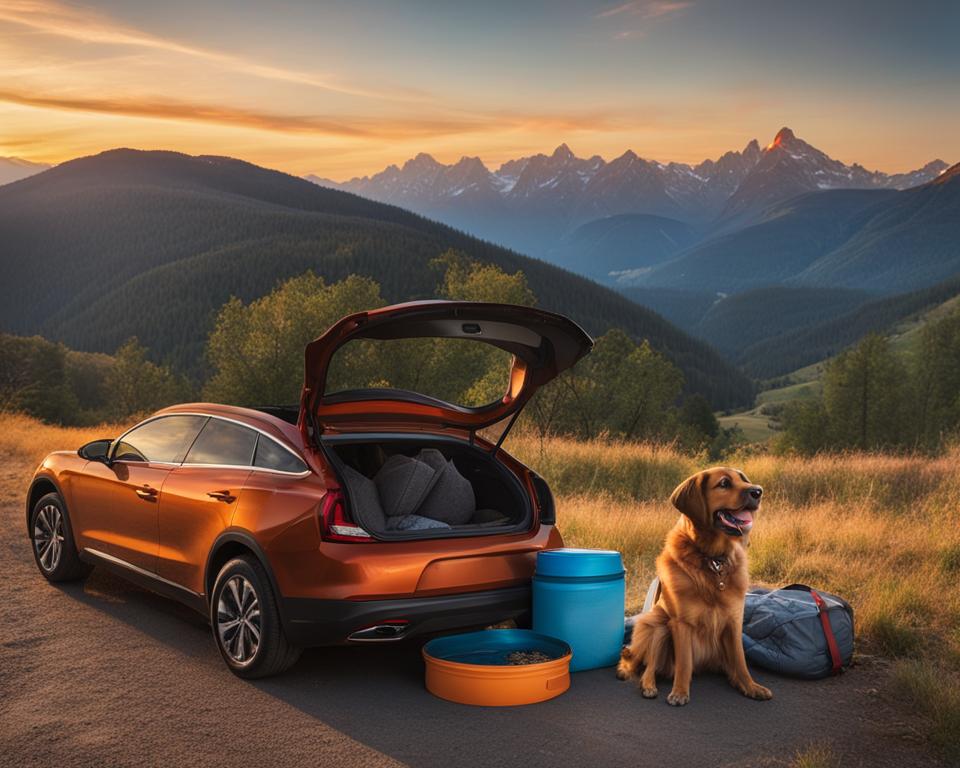
As you plan your adventure, the allure of the open road calls not just to you, but also to your four-legged friend. To ensure that every mile of your journey is a joy for you and your dog, following tips for traveling with dogs will make your dog-friendly car trips not only possible but pleasurable. What starts as a simple desire to bring your pet along can evolve into a series of delightful memories with the proper planning and attention to detail.
Choosing accommodations that truly welcome dogs goes beyond simply selecting a hotel with a pet-friendly label. Some establishments offer special touches such as pet packages, dog beds, and treats, ensuring that your companion is as comfortable as you are. It’s important to clarify these policies before you book, to avoid any surprises on arrival.
Beyond lodging, preparing a travel kit and keeping essentials close at hand is essential for maintaining the well-being of your pet throughout your travels. Here’s a snapshot of what this might look like.
| Essential Items | Why It’s Important |
|---|---|
| Familiar Toys | To provide a sense of comfort and familiarity. |
| Portable Water Bowl | To keep your dog hydrated without the mess. |
| Dog’s Regular Food | To prevent digestive upsets from a sudden change in diet. |
| Leash and Harness | For safety during breaks and at your destination. |
| Updated ID Tags | For easy identification if your dog gets lost. |
| First Aid Kit | For handling minor injuries on the go. |
When considering car travel with pets, be vigilant about providing plenty of water—especially if you’re traversing areas where temperatures can soar. A well-hydrated dog is a happy dog, less prone to heatstroke and discomfort. Packing water from a familiar source can also help prevent stomach issues that might arise from drinking water they’re not accustomed to.
Remember that your foresight in planning a trip that caters to the needs of your dog will make the experience far more rewarding. It’s these thoughtful touches, from ensuring the presence of familiar items to securing a safe and welcoming environment, that turn a simple car trip into an enriching experience for your pet companion.
Prioritizing Safety While on the Road
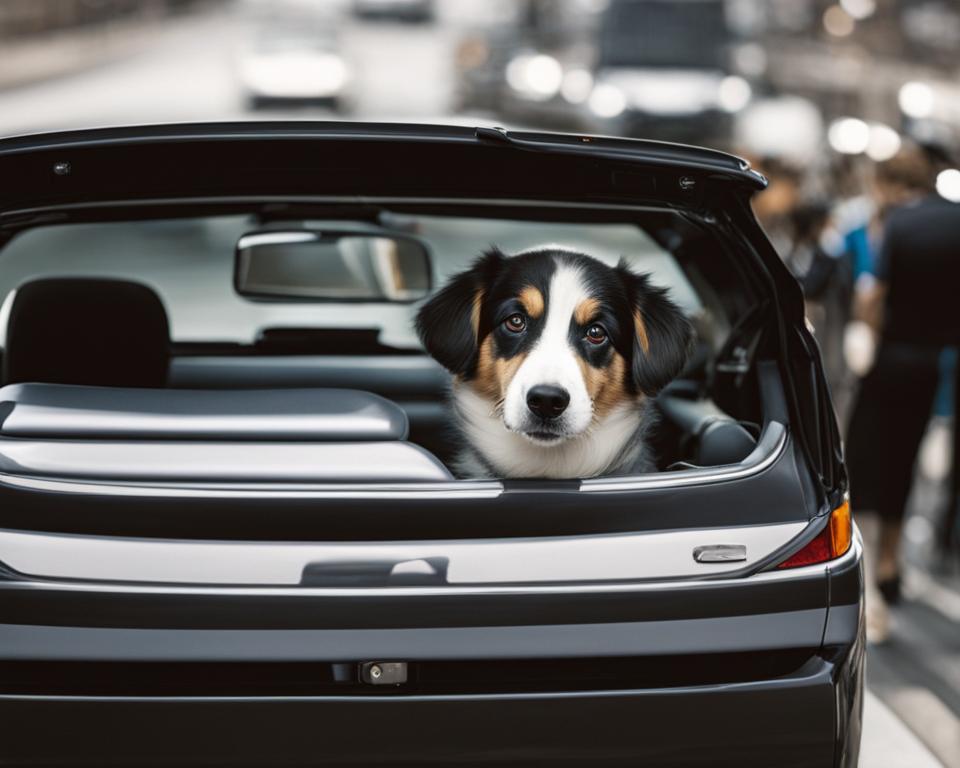
When traveling with dogs in car long distance, ensuring their safety is just as important as reaching your destination. As a responsible pet owner, it’s crucial to be informed about the best dog travel safety tips and apply them. In this section, we’ll focus on how to keep your furry companion secure and comfortable, so you both can enjoy a stress-free journey.
Importance of Restraint During Travel
Restraining your dog correctly in the car is not just about obedience – it’s about pet safety in cars. An unrestrained pet can be a significant distraction to the driver and, in the event of a collision, can become a dangerous projectile. A sturdy restraint system is essential to prevent such risks and make sure your pup remains safe throughout the trip.
Temperatures and Risks of Leaving Dogs in the Car
The danger of leaving your dog in the car, even for a brief moment, cannot be overstated. Vehicles can quickly turn into extreme environments, becoming excessively hot or dangerously cold. This risk is particularly acute during the summer and winter months, but it can occur anytime, depending on the weather and the car’s exposure to sunlight.
Dangers of Dogs Riding with Heads out the Window
While many dogs delight in sticking their heads out of the window, this iconic image of joy can quickly become perilous. Road debris or an unexpected accident could cause serious injury. Secure your pet inside the vehicle to protect them from these dangers, maintaining their safety and your peace of mind as you travel.
- Always use a crash-tested restraint system like a seatbelt harness or a secure crate.
- Never leave your dog unattended in the car, where the temperature can soar or plummet.
- Your dog may enjoy the breeze, but keeping their head inside the car is much safer.
Creating a Pet-Friendly Travel Itinerary

Embarking on a journey with your dog is not merely about covering miles; it’s about creating moments and memories. Planning a perfect road trip with your dog involves more than just safe travel arrangements; it’s about ensuring a seamless experience for you and your four-legged companion. By incorporating dog-friendly locations and amenities into your travel plan, you’ll set the stage for an adventure that caters just as much to your furry friend’s needs as to your own wanderlust.
Mapping Out Dog-Friendly Stops
When it comes to planning a road trip with dogs, setting a course that includes plentiful opportunities for your dog to stretch their legs and take bathroom breaks is essential. Identifying rest stops, dog parks, and national parks that welcome pets will keep your dog happy and healthy. Ideally, these stops should be scheduled every 2-3 hours, allowing your dog to burn off energy and maintain regular potty routines.
Identifying Pet-Friendly Accommodations in Advance
Finding places where both you and your pet feel welcome can significantly enhance your travel experience. Researching dog-friendly accommodations before your trip is crucial. When vetting hotels or Airbnb options, be sure to check for pet-related fees or restrictions and confirm that your room will be suitably equipped for a pet’s stay. Booking accommodations in advance that cater to dogs will help ensure your lodgings enhance your trip rather than adding complications.
Complying with Local Leash Laws and Restrictions
As you plan your dog-friendly car trips, it’s important to stay informed about the local leash laws and any breed-specific legislation that may impact your itinerary. Respecting these regulations is vital for the safety and well-being of your dog and it ensures that you are in compliance with local policies. This precautionary step not only allows you to avoid unnecessary disruptions but also helps protect the local wildlife and habitats you are visiting.
With these considerations in mind, you’re now equipped to create an itinerary that welcomes your dog’s presence as much as your own. So grab your map, gather your pup’s favorite toys, and start planning for a road trip that promises traveling with dogs in car long distance to be just as enjoyable as the destinations you’ll find along the way.
Emergency Preparedness and First Aid
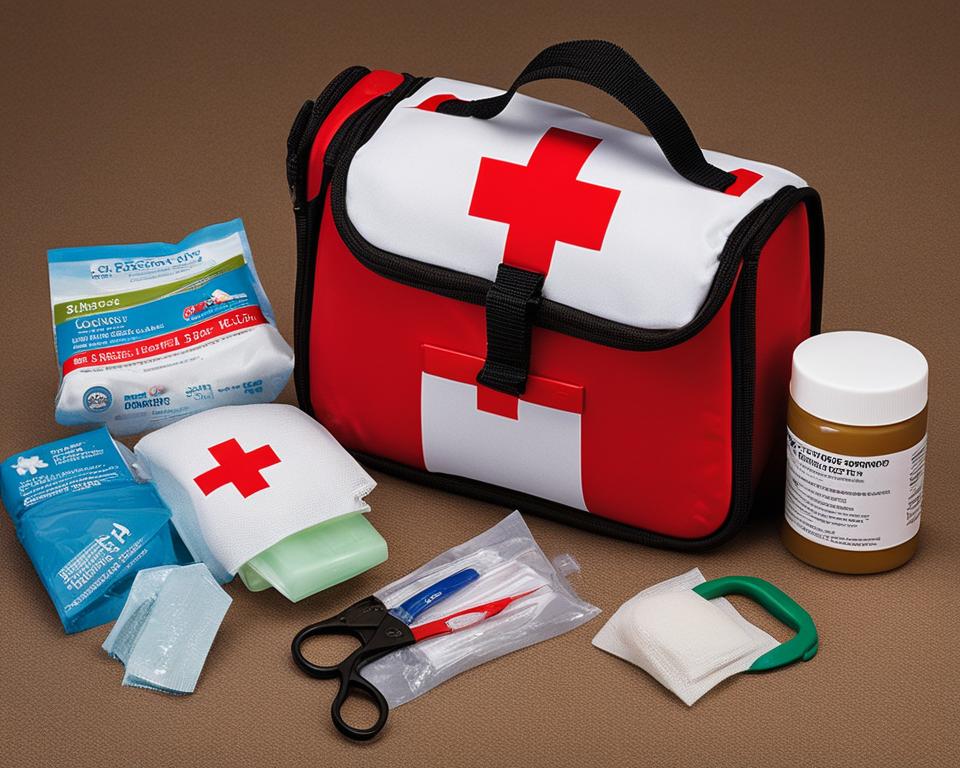
Embarking on a road trip with your furry companion calls for emergency preparedness for pets. It’s crucial to have a dog first aid kit essentials packed alongside their medical records, ensuring you’re equipped for any unforeseen incidents. You’ll find peace of mind knowing that you’re fully prepared to address any medical needs that may arise during your dog car travel adventures.
First aid preparedness is not only about having the kit but also knowing what to pack inside. Below you’ll find a helpful table listing the necessary items that should be included in your dog first aid kit. This preparation meets the dual needs of prompt, competent care and adherence to the love and responsibility you have for your pet’s health and safety.
| First Aid Item | Purpose | Notes |
|---|---|---|
| Bandages | To wrap wounds or immobilize injuries | Non-stick bandages are preferred to avoid fur sticking |
| 3% Hydrogen Peroxide | Inducing vomiting in case of poisoning (under vet guidance) | Keep in a dark bottle and replace if expired |
| Styptic Powder | To stop bleeding from nails or minor cuts | Gentle on the skin and quickly effective |
| Tweezers | Removing ticks or foreign objects | Include a pair with a fine point for small ticks |
| Scissors | Trimming bandages or fur around wounds | Blunt-ended scissors are safer |
| Gauze | For dressing wounds or as a tourniquet | Keep several sizes on hand |
| Alcohol Wipes | Cleaning and sterilizing instruments | Not for use on open wounds; for tools only |
| Emergency Contact Information | Fast access to your vet and local emergency clinics | Also include notes on your pet’s medical history/allergies |
| Prescription Medications | For treating ongoing conditions | Bring enough for the trip plus a few days extra |
Remember, the aim of emergency preparedness for pets is to minimize the impact of any health issue that may occur while away from home. Ensure your dog’s prescriptions are current and you know how to administer them. It’s also wise to familiarize yourself with the location of the nearest animal hospital relative to your various stops along the route. A solid preparation coupled with knowing how to use these dog car travel essentials can significantly aid in making a recovery from any incident smoother and swifter.
Don’t hesitate to seek professional medical advice when using your dog’s first aid kit. Your readiness to act quickly and knowledgeably can make a substantial difference in emergency situations.
Even with preventive measures in place, accidents can happen. But with the proper tools and knowledge, you’ll be better positioned to ensure your dog’s safety, allowing you both to enjoy the journey with far less worry.
Dog Car Travel Essentials: What to Pack
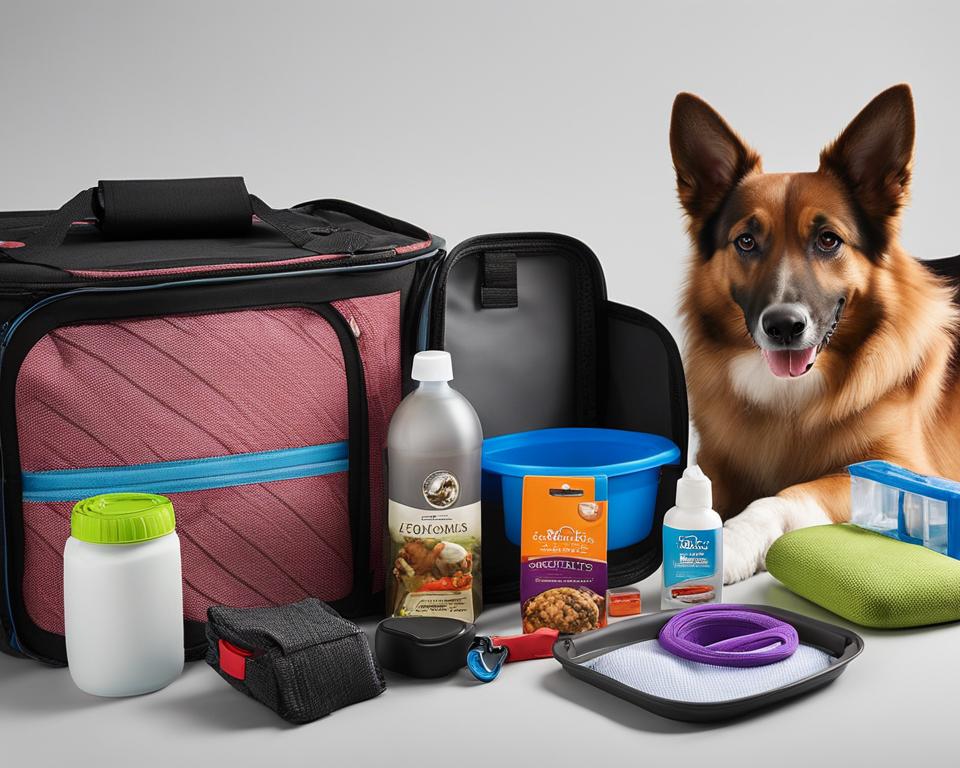
Embarking on a road trip with your canine companion means considering both comfort and safety. With the right preparations, **car travel with pets** can be a smooth experience for everyone involved. While you map out your journey’s route, it’s just as important to map out what you’ll bring along for your four-legged friend. Ensuring you have all the necessary dog car travel essentials can make the difference between a chaotic journey and a serene one. Here, we’ll explore what items should be on your packing list, how to handle first aid situations, and tips for keeping your car tidy and damage-free along the way.
Main Essentials for Your Dog’s Travel Kit
Think of your dog’s travel kit as their suitcase, packed with everything they’ll need to stay safe, comfortable, and happy. Beyond the leash and collar, this **dog travel kit** should mirror their at-home care routine as closely as possible while being prepared for the unpredictability of travel.
- ID Tags with updated contact information
- Sturdy leash and comfortable harness
- Collapsible water bowls and bottled water
- Their regular dog food and treats
- Waste bags for clean-ups on the go
- A kennel or crate for secure resting
- Favorite toys to ease stress and prevent boredom
- A dog bed or blankets for familiar scents and comfort
- Flea and tick preventive measures, especially important during hikes or in the wilderness
- Towels for drying off or emergency clean-ups
First Aid Supplies Tailored for Canines
Hope for the best but prepare for the worst—an axiom that especially applies to **dog car travel essentials**. Having a dedicated dog first aid kit can be critical in managing any potential emergencies on the road.
| First Aid Supply | Use |
|---|---|
| Vet documentation and records | Essential for proof of vaccinations and identification |
| Bandages and gauze | For dressing wounds or injuries |
| 3% Hydrogen peroxide | Used to induce vomiting under vet supervision if necessary |
| Styptic powder or pens | To quickly stop minor bleeding |
| Antiseptic wipes | For cleaning up wounds or sterilizing equipment |
| Tweezers and scissors | Removal of ticks and cutting bandages to the correct size |
| Emergency contact info | Numbers for your vet and nearest animal hospitals |
| Any ongoing prescription medications | Continued care for existing health conditions |
Protecting Your Car’s Interior During Dog Travel
So, you’re ready to hit the open road with your trusty companion by your side. However, without the right preparations, your vehicle might take a hit from all the excitement. To maintain your car’s cleanliness and resale value, consider investing in protective gear that’s easily cleaned or replaced if necessary.
- Seat covers specifically designed for pets, to shield against nails and spills
- Durable floor liners for capturing mud, water, and fur
- Waterproof cargo liners, ideal for keeping the trunk area mess-free when transporting a pet crate or supplies
- Window screens to prevent drool marks and add shade
- Portable vacuum cleaner for pets, making it easy to tackle fur on upholstery
With this comprehensive guide to a **dog travel kit**, you’ll be set for any adventure ahead. Of course, these preparations don’t just ensure the well-being of your dog; they also provide you with the peace of mind that comes from knowing you’re ready for whatever the road throws your way. Safe travels!
Considering Alternate Modes of Pet Transportation
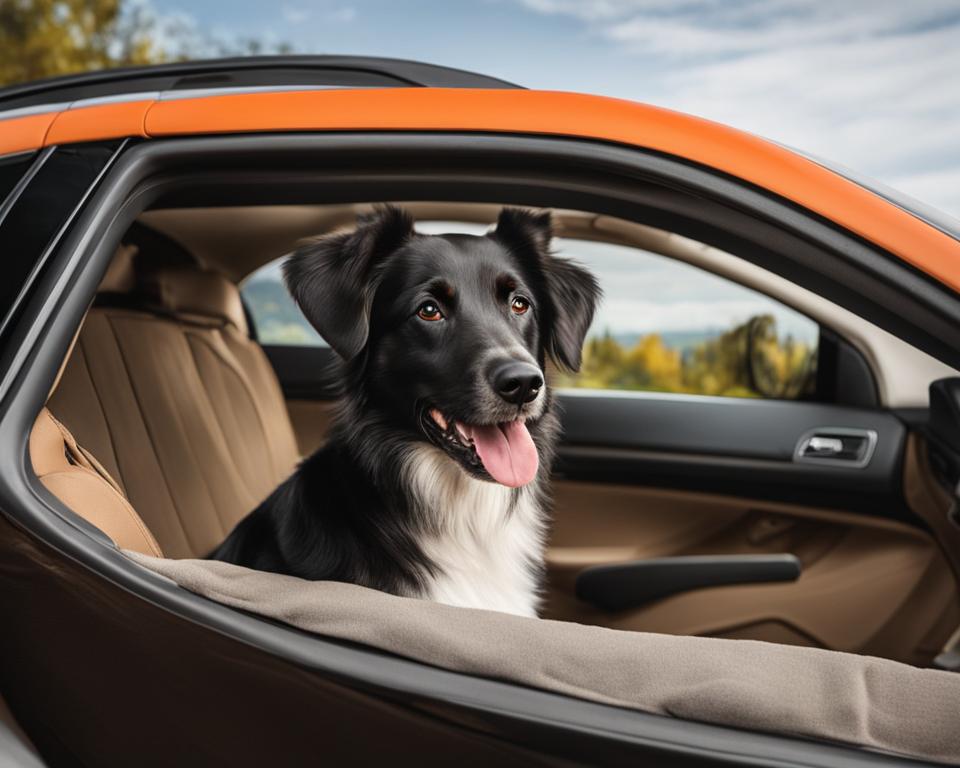
While a classic road journey remains a cherished way of planning a road trip with dogs, broadening your horizons to alternate methods of pet travel might present you with surprising conveniences and enriching experiences. Should you be weighing the options of pet-friendly transportation, let’s venture into the world of planes, trains, and boats to discern the best course for you and your canine companion.
Traveling by air introduces complexities not found in car travel. Certain dog breeds, especially those with short nasal passages like bulldogs and pugs, are notably more vulnerable to airline travel, facing potential oxygen deprivation and heat stroke challenges. As such, it is imperative to verify that your dog meets the specific airline’s requirements for cabin travel and to ensure you have the correct type of carrier well in advance.
Before booking a flight, cross-check with the airline for their pet travel policies, which often include breed, size, and health certificate stipulations. Always prioritize your pet’s welfare when considering this mode of travel.
Trains offer a scenic and sometimes more relaxed alternative, although here too, your pet will face certain restrictions. Amtrak allows dogs up to 25 pounds, and some smaller train companies may have more lenient guidelines. European train travel tends to be more pet-accommodating, with numerous routes allowing dogs.
For the seafaring pet owner, cruise ships might offer an exciting possibility. However, policies vary greatly—some cruise lines provide pet-friendly cabins, while others might place pets in onboard kennels, especially during long ocean crossings.
The following table summarizes key information regarding pet travel on different transportation modes, serving as a quick reference to help you plan your journey:
| Transportation Type | Considerations | Pet Restrictions | Preparation Tips |
|---|---|---|---|
| Air Travel | Breed-specific risks, in-cabin requirements | Limited to small-size breeds for cabin | Carrier compliance, health certificates, advance booking |
| Train Travel | Weight restrictions, limited routes | Typically under 25 pounds | Check individual train company policies, prepare necessary documents |
| Boat Travel | Varied cabin policies, kennel availability | Often only allowed on certain crossings | Confirm pet policy, plan for onboard or kennel accommodations |
Regardless of the mode, be thorough in your research and planning to provide your dog the safest and most enjoyable journey possible. Pet-friendly transportation options may at first glance seem daunting, but with careful consideration, you can make the travel adventure with your pet worry-free and filled with pleasant memories.
Conclusion
As we wrap up our comprehensive guide on **best practices for traveling with dogs**, it’s clear that the key to a successful and **safe long-distance travel with pets** starts much before you turn the ignition. We’ve delved into the nuances of preparation, from securing proper identification to acclimating your dog to road trips, each step ensuring a harmonious journey for you and your companion. Now, let’s recap the highlights and leave you with some parting wisdom for the road.
Recapping the Key Points for Safe Long-Distance Travel with Dogs
Remember, effective restraint systems are non-negotiable for on-the-move safety, while meal timing and regular water breaks can help keep your furry friend at ease. Packing a travel kit with familiar comforts and a first-aid kit addresses both routine and emergency needs. Keeping your dog’s head inside the vehicle and never leaving them unattended ensures their protection against unpredictable elements and potential dangers.
Emphasizing the Importance of Preparation and Safety
A stitch in time saves nine, and nowhere is this truer than in preparing for a journey with your dog. Meticulous planning, which includes understanding and respecting local leash laws and identifying dog-friendly venues, forms the foundation of **enjoying road trips with dogs**. By tailoring your itinerary to include spacious stops for your dog to play and relax, you guarantee a trip that is as much a treat for them as it is for you.
Parting Thoughts on Enjoying the Road Trip with Your Canine Companion
In essence, the joy of a road trip is enhanced manifold when shared with your dog. By prioritizing safety, comfort, and the thrill of exploration, your travel narrative will be rich with tales of shared adventures and bonding moments. Whether you’re scaling mountains, crossing state lines, or simply breathing in the beauty of a roadside vista, the shared experiences with your trusted canine friend will forge an unbreakable bond. So here’s to adventures on the open road—may they be filled with wagging tails, new horizons, and the kind of joy that comes from making memories with your furry family member.
FAQ
What are the best practices for a dog-friendly car trip?
To ensure a pleasant and safe trip with your dog, provide them with a proper restraint system, keep the car at a comfortable temperature, and pack all the essentials such as a travel kit with food, water, and first aid supplies. Regularly stop for breaks and keep your dog hydrated throughout the journey.
How can I prepare my dog for long distance travel?
Gradually acclimate your dog to car travel by taking short drives and incrementally increasing duration. Feed your dog a light meal a few hours before the trip to prevent motion sickness and maintain routine by bringing familiar items from home.
What essential items should I pack for my dog on a road trip?
Your dog’s travel kit should include food, water, bowls, leash, waste bags, first aid supplies, medications, toys, a familiar bed or blanket, and up-to-date identification and medical records. Also, ensure you have a method to safely restrain your dog inside the car, like a kennel or safety harness.
Why is proper identification and documentation important for traveling with dogs?
Proper identification, such as a collar with an ID tag and a microchip, helps ensure your dog can be returned to you if lost. Carry documentation including vaccination records and health certificates, which may be required at certain destinations or accommodations.
How should I choose a restraint system for my dog in the car?
Select a restraint system that keeps your dog securely in place, but allows them to lie down, stand, and turn around comfortably. Options include a crash-tested dog safety harness or a properly sized travel crate that’s anchored to the vehicle.
What safety measures should I take when traveling with my dog in a car?
Always use a dog restraint system to minimize distractions and protect your pet in case of an accident. Be aware of the temperature inside your car and never leave your dog unattended. Additionally, keep the car windows closed enough to prevent your dog from sticking their head out and risking injury.
How do I create a pet-friendly travel itinerary?
Research and plan stops at dog-friendly locations for breaks, exercise, and overnight stays. Identify pet-friendly hotels and verify their policies in advance. Also, familiarize yourself with local leash laws and any breed-specific restrictions along your route.
What are some tips for maintaining my car’s interior during dog travel?
Protect your car’s interior against dirt, pet hair, and damage by using waterproof seat covers and floor liners. Also, have towels and cleaning supplies on hand for any messes, and ensure your pet is clean and dry before entering the vehicle.
Are there alternatives to car travel for pets?
Yes, other transportation methods include flying, train rides, or cruises, each with specific regulations and restrictions regarding pet travel. Always check guidelines and prepare the proper carriers or kennels as required by the carrier or destination.
How can I ensure my dog’s safety during a road trip?
Prioritize your dog’s well-being by using a reliable restraint system, planning for regular stops, and preparing for emergencies with a comprehensive first aid kit. Double-check that your pet’s ID tags, microchip, and travel documentation are up-to-date before your departure.

